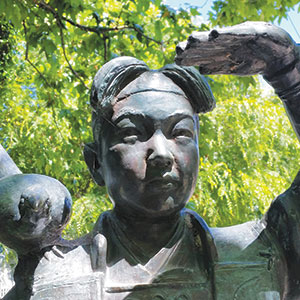

Tucked away behind the San Jose Center for Performing Arts, right at the edge of the Guadalupe River, the Peach Boy remains somewhat hidden underneath the bushes. The statue of Momotaro, a hero of Japanese folklore, was gifted to San Jose by the city of Okayama in 1993. Upon a recent visit, the statue was cluttered with a few cobwebs, but it still retained an austere mythological status.
Just as the statue is off the radar for most people, so are the myriad activities of San Jose Okayama Sister Cities (SJOSC), a local non-profit group of volunteers. At any given time, SJOSC orchestrates a matrix of initiatives to enhance human connections between the two cities. In particular, last year five high school kids from San Jose traveled to Okayama with a chaperone and stayed with a host family during a citywide program where children from 80 different international cities all exchanged students with Japan. The San Jose kids returned with their perceptions shattered.
“They came back and they said, ‘Japan is so clean. Everything is clean. There’s no litter, there’s no trash cans,'” explained SJOSC President Kathy Sakamoto over coffee at Roy’s Station, adding that one girl took ketchup packets with her because she didn’t know if they would be available in Japan. “But ketchup is a flavor in Japan,” Sakamoto said. “So little kids love ketchup-flavored spaghetti.”
Now Okayama wants to return the favor and bring eight kids to San Jose. SJOSC is currently looking for host families and/or funds to support the exchange. Sakamoto says it’s a great way to understand what other countries are doing and how America is perceived elsewhere.
Such a program is why Sister Cities International began in 1956. Following President Eisenhower’s Conference on Citizen Diplomacy, Ike met with leaders from many fields and came up with a new initiative to engage private citizens in international diplomacy, the idea being that face-to-face, person-to-person contact between individuals of different countries, in non-governmental situations, can help advance the cause of peace, slowly, one person at a time.
San Jose established a rapport with Okayama one year later, in 1957, making it the third oldest Sister City relationship in the US. By now, over 500 communities maintain over 2,000 partnerships in more than 140 countries. San Jose’s other sister cities include Dublin, Ireland; Veracruz, Mexico; Tainan, Taiwan; Pune, India; Ekaterinburg, Russia, San Jose, Costa Rica; and most recently, Guadalajara, Mexico.
The San Jose Okayama relationship is a huge one, much more elaborate than smiling politicians trading handshakes and photo ops. The Japanese Friendship Garden in Kelley Park, for example, is modeled after the Korakuen Garden on the grounds of Okayama Castle, a landscape originally built in 1687. When San Jose built the garden, the Okayama city government even sent the original koi fish. After the 2017 floods wrecked part of the garden and sent the fish sprawling into the bushes and sidewalks, a volunteer effort was launched to restore the facility, an effort still ongoing, and another one always in need of sponsors and support.
To cite another example, 2007 was the 50th anniversary of the San Jose Okayama relationship, so a delegation of 300 Japanese flew to San Jose in a 747, before the airport was fully remodeled. The plane was able to land, but at the end of the delegation’s visit, a 747 with 300 people was too heavy to take off from SJC’s runway. So the pilots had to fly the empty plane from San Jose to San Francisco and the entire 300-person delegation was then bused up 101 to board the plane at SFO. Nowadays SJC is much more accommodating.
In 2017, a smaller delegation of just over 100 people likewise visited San Jose for the 60th anniversary. They attended City Hall events and toured the area, just to learn more about San Jose. All of which exemplifies what Sister Cities are about: teaching citizens about other countries.
“We want this to continue because we’re just on this little planet, all of us, and we can get better,” Sakamoto told me. “We can live longer. We can improve everybody’s lives if we are open, and we can continue relationships that are people-to-people relationships.”
sanjoseokayamasistercities.com



